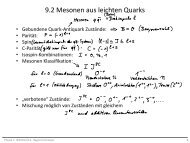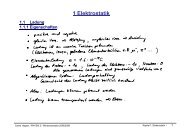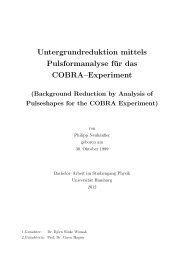Setup of a Drift Tube Muon Tracker and Calibration of Muon ...
Setup of a Drift Tube Muon Tracker and Calibration of Muon ...
Setup of a Drift Tube Muon Tracker and Calibration of Muon ...
Create successful ePaper yourself
Turn your PDF publications into a flip-book with our unique Google optimized e-Paper software.
(typically below 50 cm), the location <strong>of</strong> the cosmogenic induced carbon nuclei canbe found in the intersection <strong>of</strong> a sphere around the location <strong>of</strong> the neutron capture<strong>and</strong> a cylinder around the muon track. Any signal occurring within this regionduring a few half-lives <strong>of</strong> the 11 C can now be vetoed thus reducing the cosmogenicbackground. However, it is desirable to keep the excluded region <strong>of</strong> fiducial volumesmall, in order to not reduce the overall statistics too much. Therefore, a goodmuon tracking is needed. Fig. 4.4 shows the schematic principle <strong>of</strong> the three foldcoincidence. For a detailed description see [72].4.3.4 <strong>Muon</strong> Identification <strong>and</strong> Tracking<strong>Muon</strong>s crossing Borexino are identified using several techniques. Light from the outerdetector Čerenkov veto is a strong indicator for muons. Also the inner detector canbe used by performing a pulse shape <strong>and</strong> timing analysis <strong>of</strong> the PMT signals: muonpulses feature longer rise <strong>and</strong> decay times than neutrino events <strong>of</strong> comparable energy.Thus, the outer <strong>and</strong> inner detector provide two independent <strong>and</strong> yet redundant tagsfor cosmic muons.For the reconstruction <strong>of</strong> muon tracks, two different algorithms are used. One isbased on the data from the outer detector <strong>and</strong> the other uses the information fromthe inner detector. A combination <strong>of</strong> the OD <strong>and</strong> ID fits is then further used for athird, global tracking. A brief overview <strong>of</strong> the tracking algorithms is presented here.The characteristic light patterns created by muons crossing Borexino are usedto reconstruct the muon tracks. For the OD tracking, the disk-like shapes from theČerenkov cone <strong>of</strong> a crossing muon are identified by the PMTs close to the muon’sentry point to the detector <strong>and</strong> after a time delay also close to the exit point.PMTs close to the entry point show significantly more photons registered than thosefurther away. Also, the Čerenkov light reaches these PMTs earlier. Depending onthe inclination <strong>of</strong> the track, the time pr<strong>of</strong>ile <strong>of</strong> the hits corresponds to a circle or anellipse around the entry point. Once the two clusters <strong>of</strong> PMTs indicating a crossingmuon have been identified, the entry <strong>and</strong> exit points are determined by the chargebarycenters <strong>of</strong> these clusters. A detailed description <strong>of</strong> the tracking algorithm ispresented in [71].The inner detector tracking relies mainly on the distinct patterns <strong>of</strong> the photonarrival times at the PMTs. Due to the high light output from crossing muons, thecharge distribution <strong>of</strong> the PMTs cannot be used for the track reconstruction. Amuon crossing the inner detector produces both scintillation <strong>and</strong> Čerenkov light.The Čerenkov light is emitted as the typical forward bound Čerenkov cone whereasthe scintillation light evolves in all directions. First, the entry point is identified bythe backward running scintillation light. For a first approximation, the time pattern<strong>of</strong> the hits registered within the first 5 ns <strong>of</strong> the event is analyzed. The exit pointis then identified by determining the symmetry plane dividing the photon arrivalpattern <strong>of</strong> the PMTs in half. This plane has to go through both the entry <strong>and</strong>exit point <strong>of</strong> the tracks, as well as through the center <strong>of</strong> the SSS, <strong>of</strong> which two arealready known. Having found this plane already allows a rough determination <strong>of</strong>the azimuth angle <strong>of</strong> the muon track. To get an even better result, twelve planesperpendicular to the symmetry plane in rising distance from the entry point areinvestigated. The arrival times at the PMTs in each plane show a minimum aroundthe track’s azimuth angle ϕ when plotted against the azimuth location <strong>of</strong> the PMT.60





